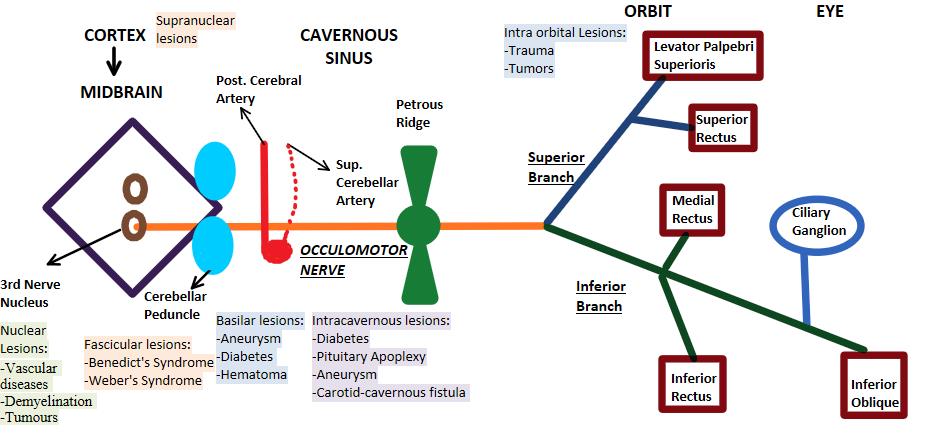[1]
Kim K, Noh SR, Kang MS, Jin KH. Clinical Course and Prognostic Factors of Acquired Third, Fourth, and Sixth Cranial Nerve Palsy in Korean Patients. Korean journal of ophthalmology : KJO. 2018 Jun:32(3):221-227. doi: 10.3341/kjo.2017.0051. Epub 2018 Mar 20
[PubMed PMID: 29770635]
[2]
Singh A, Bahuguna C, Nagpal R, Kumar B. Surgical management of third nerve palsy. Oman journal of ophthalmology. 2016 May-Aug:9(2):80-6. doi: 10.4103/0974-620X.184509. Epub
[PubMed PMID: 27433033]
[3]
Tamhankar MA, Biousse V, Ying GS, Prasad S, Subramanian PS, Lee MS, Eggenberger E, Moss HE, Pineles S, Bennett J, Osborne B, Volpe NJ, Liu GT, Bruce BB, Newman NJ, Galetta SL, Balcer LJ. Isolated third, fourth, and sixth cranial nerve palsies from presumed microvascular versus other causes: a prospective study. Ophthalmology. 2013 Nov:120(11):2264-9. doi: 10.1016/j.ophtha.2013.04.009. Epub 2013 Jun 6
[PubMed PMID: 23747163]
[4]
Chaudhry NS, Brunozzi D, Shakur SF, Charbel FT, Alaraj A. Ruptured posterior cerebral artery aneurysm presenting with a contralateral cranial nerve III palsy: A case report. Surgical neurology international. 2018:9():52. doi: 10.4103/sni.sni_430_17. Epub 2018 Mar 1
[PubMed PMID: 29576903]
Level 3 (low-level) evidence
[5]
Alswaina N, Elkhamary SM, Shammari MA, Khan AO. Ophthalmic Features of Outpatient Children Diagnosed with Intracranial Space-Occupying Lesions by Ophthalmologists. Middle East African journal of ophthalmology. 2015 Jul-Sep:22(3):327-30. doi: 10.4103/0974-9233.159739. Epub
[PubMed PMID: 26180471]
[6]
Keane JR. Third nerve palsy: analysis of 1400 personally-examined inpatients. The Canadian journal of neurological sciences. Le journal canadien des sciences neurologiques. 2010 Sep:37(5):662-70
[PubMed PMID: 21059515]
[7]
Fang C, Leavitt JA, Hodge DO, Holmes JM, Mohney BG, Chen JJ. Incidence and Etiologies of Acquired Third Nerve Palsy Using a Population-Based Method. JAMA ophthalmology. 2017 Jan 1:135(1):23-28. doi: 10.1001/jamaophthalmol.2016.4456. Epub
[PubMed PMID: 27893002]
[8]
Flanders M, Hasan J, Al-Mujaini A. Partial third cranial nerve palsy: clinical characteristics and surgical management. Canadian journal of ophthalmology. Journal canadien d'ophtalmologie. 2012 Jun:47(3):321-5. doi: 10.1016/j.jcjo.2012.03.030. Epub
[PubMed PMID: 22687316]
[9]
Motoyama Y, Nonaka J, Hironaka Y, Park YS, Nakase H. Pupil-sparing oculomotor nerve palsy caused by upward compression of a large posterior communicating artery aneurysm. Case report. Neurologia medico-chirurgica. 2012:52(4):202-5
[PubMed PMID: 22522330]
Level 3 (low-level) evidence
[10]
Komurcu HF, Ayberk G, Ozveren MF, Anlar O. Pituitary adenoma apoplexy presenting with bilateral third nerve palsy and bilateral proptosis: a case report. Medical principles and practice : international journal of the Kuwait University, Health Science Centre. 2012:21(3):285-7. doi: 10.1159/000334783. Epub 2011 Dec 8
[PubMed PMID: 22156441]
Level 3 (low-level) evidence
[11]
Kim JH, Hwang JM. Imaging of Cranial Nerves III, IV, VI in Congenital Cranial Dysinnervation Disorders. Korean journal of ophthalmology : KJO. 2017 Jun:31(3):183-193. doi: 10.3341/kjo.2017.0024. Epub 2017 May 12
[PubMed PMID: 28534340]
[12]
Talebnejad MR, Sharifi M, Nowroozzadeh MH. The role of Botulinum toxin in management of acute traumatic third-nerve palsy. Journal of AAPOS : the official publication of the American Association for Pediatric Ophthalmology and Strabismus. 2008 Oct:12(5):510-3. doi: 10.1016/j.jaapos.2008.03.009. Epub 2008 Jun 16
[PubMed PMID: 18558505]
[13]
Kattleman B, Flanders M, Wise J. Supramaximal horizontal rectus surgery in the management of third and sixth nerve palsy. Canadian journal of ophthalmology. Journal canadien d'ophtalmologie. 1986 Oct:21(6):227-30
[PubMed PMID: 3779510]
[14]
Wang WX, Xu BN, Wang FY, Wu C, Sun ZH. Microsurgical management of posterior cerebral artery aneurysms: A report of thirty cases in modern era. British journal of neurosurgery. 2015 Jun:29(3):406-12. doi: 10.3109/02688697.2015.1004301. Epub 2015 Feb 20
[PubMed PMID: 25697238]
Level 3 (low-level) evidence
[15]
De Silva DA, Siow HC. A case report of ophthalmoplegic migraine: a differential diagnosis of third nerve palsy. Cephalalgia : an international journal of headache. 2005 Oct:25(10):827-30
[PubMed PMID: 16162261]
Level 3 (low-level) evidence
[16]
Schumacher-Feero LA,Yoo KW,Solari FM,Biglan AW, Third cranial nerve palsy in children. American journal of ophthalmology. 1999 Aug
[PubMed PMID: 10458179]
